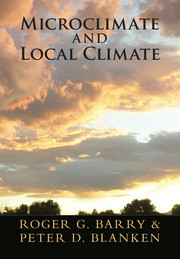1 - Introduction
Published online by Cambridge University Press: 05 May 2016
Summary
This chapter starts by defining micro- and local climates. It then outlines the scope of the book, and this section is followed by a survey of the historical development of these fields of study. The central problem of scales of local and microclimates is then addressed, and the chapter concludes with the results of a case study of microclimatic variations.
Definitions
Climate is typically described from standard measurements of temperature and humidity recorded by instruments exposed in a meteorological shelter (Stevenson screen) at a height of about 1.5–2 m. Wind velocity is recorded on a mast at a height of 10 m. However, conditions change rapidly in the underlying air layer immediately above ground where plants, animals, and insects live. In the case of forest canopies, the effective surface on which atmospheric processes operate is elevated well above the ground. The climate of these complex environments cannot be determined from the standard meteorological measurements, and hence special observations and a whole theoretical framework are required to describe them. This is the domain of micrometeorology and microclimatology.
Microclimatology is the study of climates near the ground and in the soil, the factors that affect them, and the relationships and interactions between plants, insects, and other animals and their local environment. Microclimates are usually defined vertically in terms of the plant canopy height and so range from a few centimeters in tundra areas to about 50 m in tropical rain forests. Horizontally, they may extend between a meter and several kilometers. Micrometeorological processes operate on a time scale of seconds to minutes and spatial scales of centimeters to a few hundred meters (see Figure 1.1).
Microclimatic phenomena involve climatic averages (hours to years) on these same spatial scales. Scale concepts in climatology (Barry, 1970) illustrate the spatial and temporal characteristics of microclimates.
Baum and Court (1949) defined microclimatology as the study of the geographical distributions, both horizontally (up to a few kilometers) and vertically, of air layers near the ground and the understanding of their physics. However, this appears to merge micro- and topoclimatology. Contemporary definitions of microclimate are focused on the critical layer of the interface between the surface and atmosphere, where the boundary conditions have a large impact not only on the troposphere, but also on the abiotic conditions for life itself.
- Type
- Chapter
- Information
- Microclimate and Local Climate , pp. 1 - 8Publisher: Cambridge University PressPrint publication year: 2016



